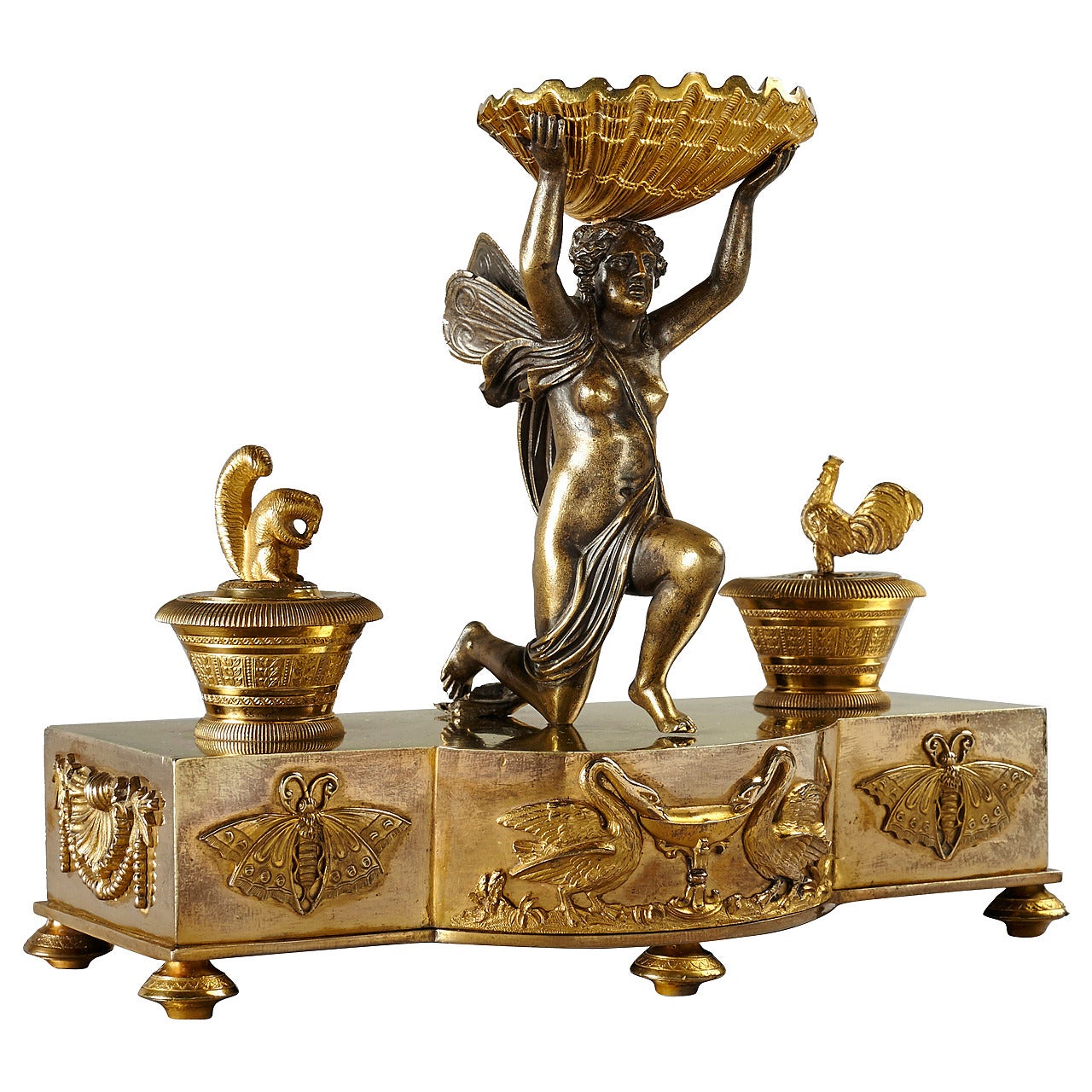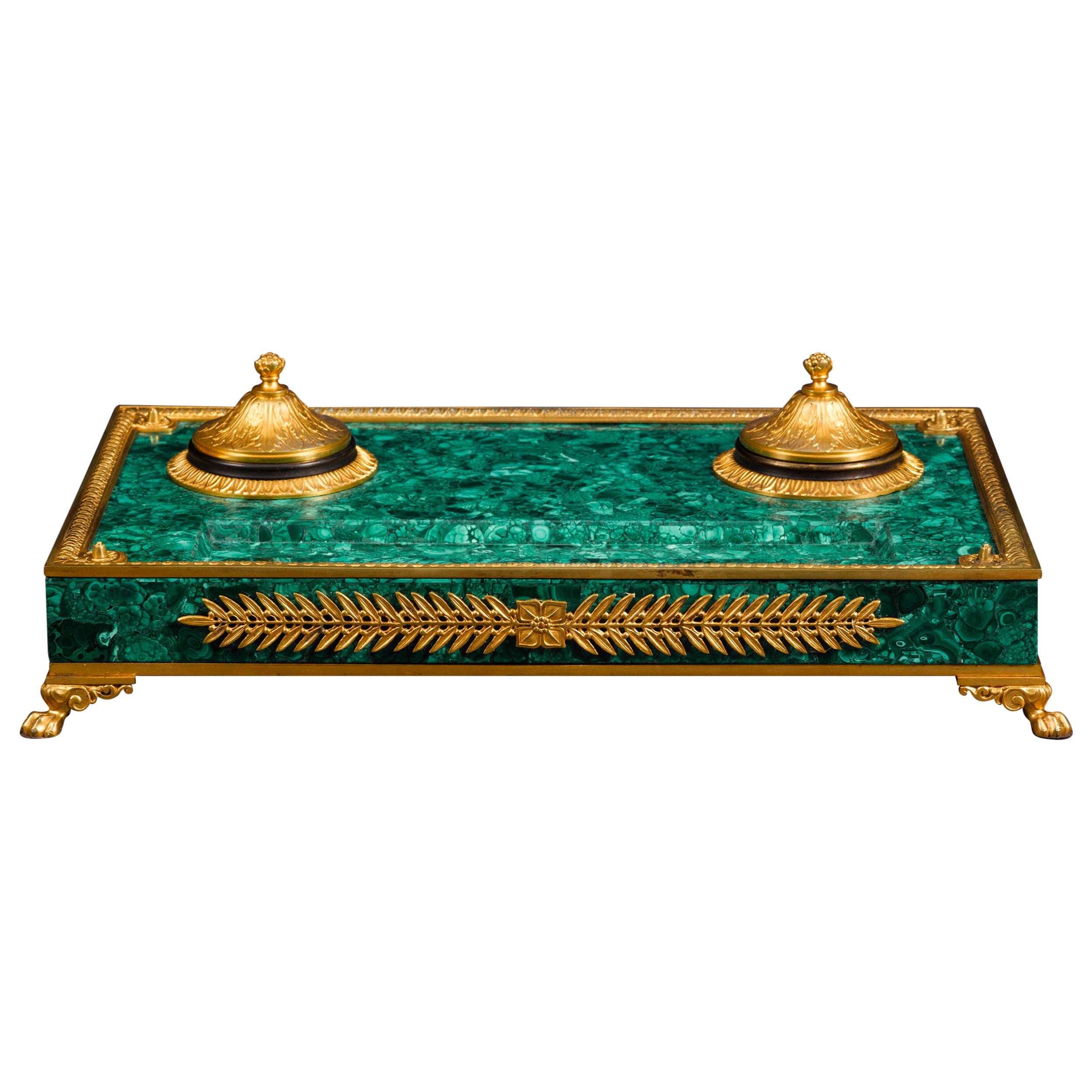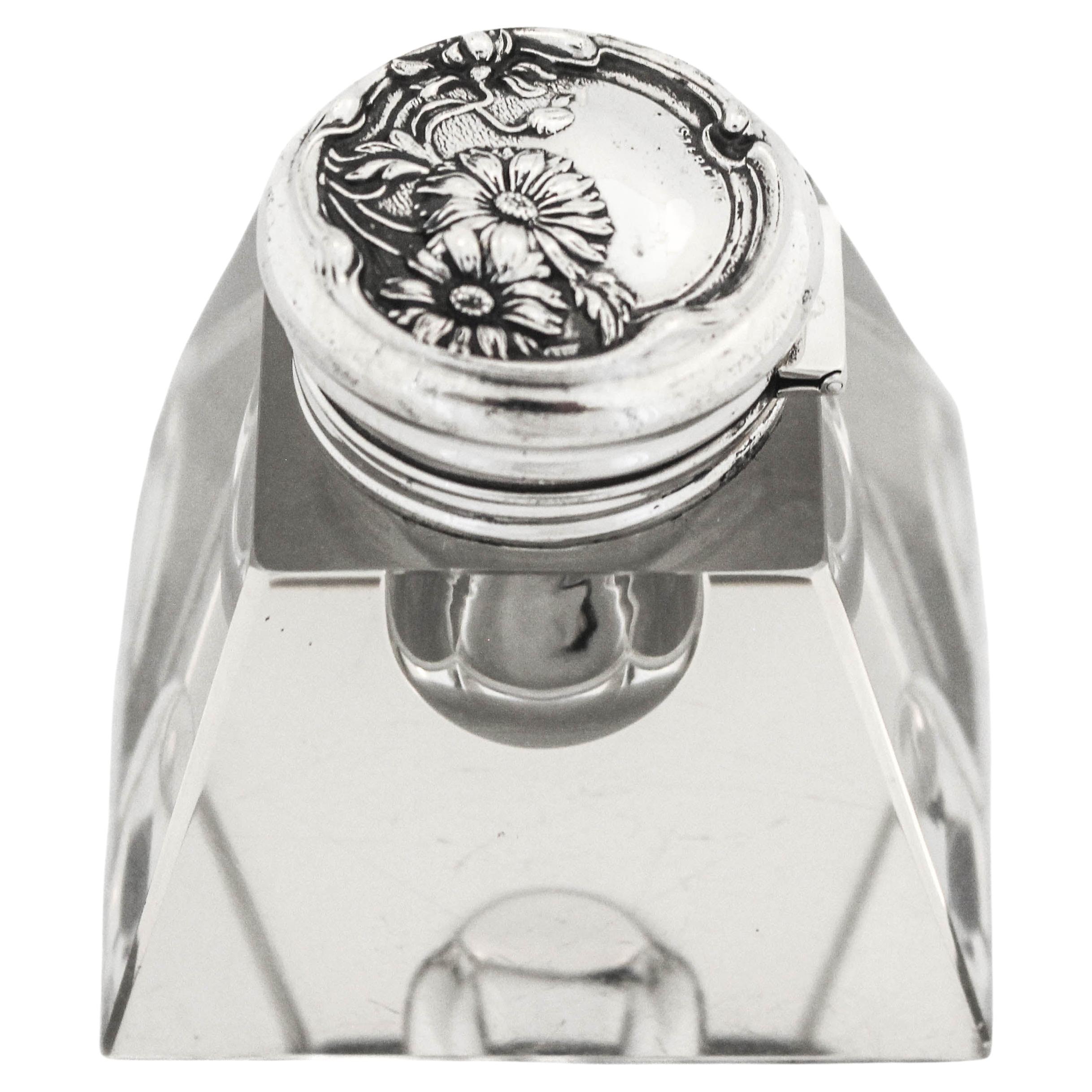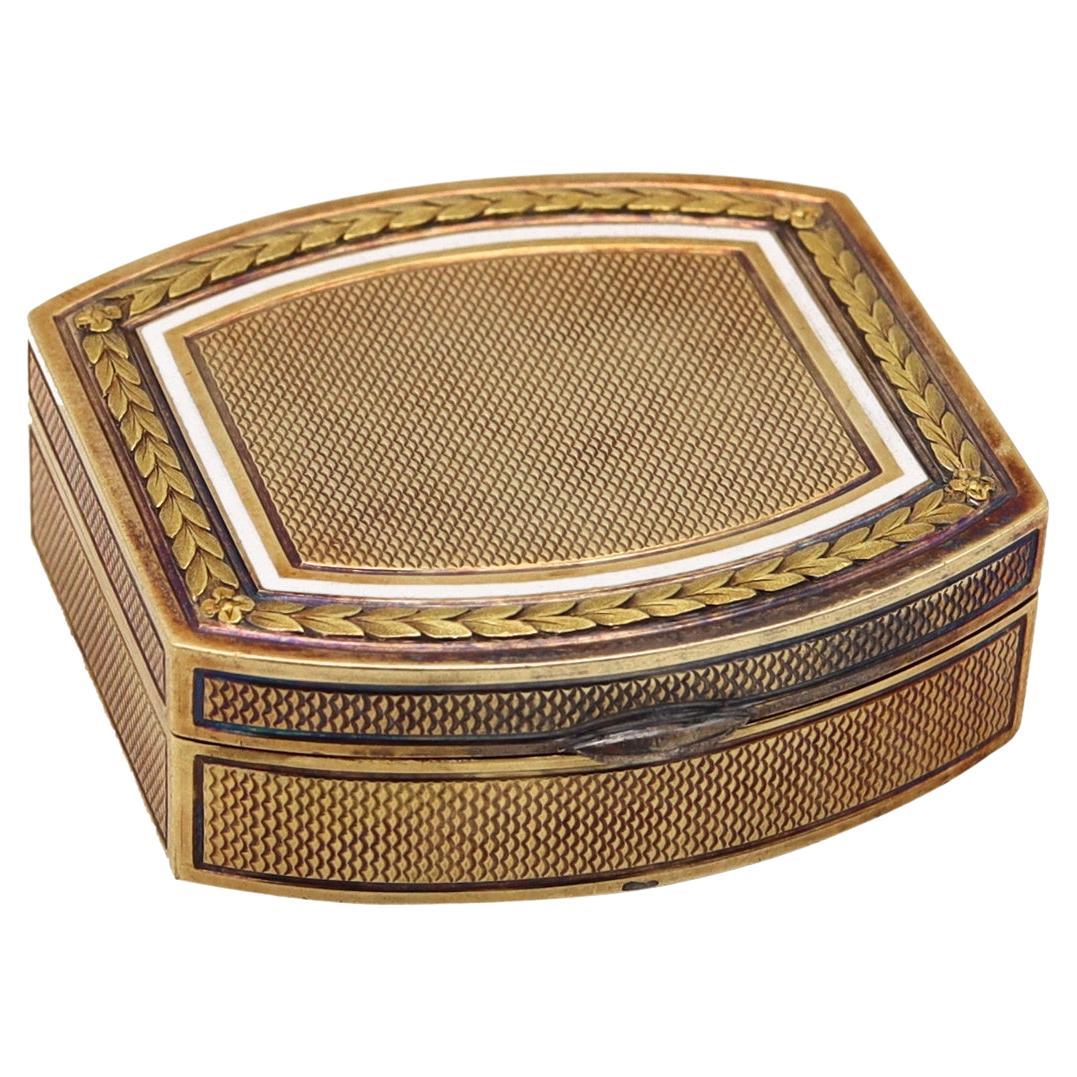Items Similar to A Russian silver inkwell, jeweler: Johann Fredrik Akerblom, St. Petersburg 1836.
Video Loading
Want more images or videos?
Request additional images or videos from the seller
1 of 15
A Russian silver inkwell, jeweler: Johann Fredrik Akerblom, St. Petersburg 1836.
About the Item
A Russian silver figured inkwell, jeweler: Johann Fredrik Akerblom, taster Mikhail Mikhailovich Karpinshií. Cylindrical inkwell raised on four feet with chiseled and knurled floral edges. The cylindrical top is hinged with an urn-shaped terminal; the front with a cast relief depicting Saint George and the dragon, on the back, framed by a coat of arms, the imperial coat of arms, depicting a double-headed eagle holding the insignia of power (globe and scepter) and the crown above the two heads. The sides are surmounted by finely chiseled, dressed, cast figures of two mice, one with a knife, the other with a hatchet. Marks: I.F.A., M.K/1836, 84. Mice also bear the mark 84.
St. Petersburg, Russia 1836.
- Dimensions:Height: 3.5 in (8.89 cm)Width: 4 in (10.16 cm)Depth: 2 in (5.08 cm)
- Materials and Techniques:
- Place of Origin:
- Period:
- Date of Manufacture:1836
- Condition:Wear consistent with age and use.
- Seller Location:Milan, IT
- Reference Number:1stDibs: LU917136932942
About the Seller
5.0
Vetted Seller
These experienced sellers undergo a comprehensive evaluation by our team of in-house experts.
Established in 1991
1stDibs seller since 2011
212 sales on 1stDibs
Typical response time: 7 hours
- ShippingRetrieving quote...Ships From: Milan, Italy
- Return PolicyA return for this item may be initiated within 7 days of delivery.
More From This SellerView All
- Art Noveau Inkwell, France, 1900Located in Milan, ITGlass inkwell with silver art nouveau iris flowers. France 1900 ca.Category
Early 20th Century French Art Nouveau Inkwells
MaterialsSilver
- Ceramic inkwell-pen holder depicting a Pierrot, Austria 1930.Located in Milan, ITAn inkwell and pen holder, made of painted ceramic, depicting the character of Pierrot from the Commedia dell'Arte. Austria circa 1930.Category
Early 20th Century Austrian Inkwells
MaterialsCeramic
- Eagle Bronze Inkwell, Signed Anton Puchegger, Austria, circa 1890Located in Milan, ITEagle bronze inkwell. Over the rectangular base rise the sculpture which spins revealing the ink reservoir. Ivory beak. Signed A.Puchegger (1878 – 1917). Austria 1890 ca. (SHIP TO EU...Category
Antique Late 19th Century Austrian Inkwells
MaterialsBronze
- French Marble and Bronze Inkwell Signed Ferdinand Barbedienne, Paris, circa 1870By Ferdinand BarbedienneLocated in Milan, ITA Verona red marble remarkable inkwell, pure Empire style representing a gilded bronze of the bust of Antinous as Dioniso. Empire style, Generous size, excellent state of preservatio...Category
Antique 1860s French Empire Inkwells
MaterialsMarble, Bronze
- Pantograph Signed Lennel, Paris, 1780Located in Milan, ITBrass and ebony pantograph, in its original mahogany box. Bone wheels. The instrument shows the signature of the maker Lennel à La Sphére à Paris. France, 1780.Category
Antique 1780s British Scientific Instruments
MaterialsBrass
- Barometer Signed Jecker, Paris 1800Located in Milan, ITMahogany wall barometer consisting of a glass tube containing mercury with its reserve. On the top part a chevron shaped pediment and a screwed brass plate with a small alcohol ther...Category
Antique Early 19th Century French Scientific Instruments
MaterialsBrass
You May Also Like
- Fine Early 19th Century Empire Russian Inkstand, St. Petersburg, circa 1810Located in Worpswede / Bremen, DEA fine Russian Empire gilt- and patinated bronze desk top inkstand, St. Petersburg, circa 1810. Rectangular shaped base raised on four turned fee...Category
Antique Early 19th Century Russian Empire Inkwells
MaterialsBronze
- Russian Malachite and Bronze InkwellLocated in New Orleans, LAMalachite is one of Russia’s most prestigious stones, and its use in the creation of this rare and opulent inkwell indicates commission and ownership by an individual of considerable status. Wonderful doré bronze accents are the perfect complement to the vivid green stone. Two dipping wells and pen tray make this inkwell as functional as it is beautiful, circa 1890. Dimensions: 18 1/4” wide x 11” deep x 5 1/2” high. The 19th century proved to be the golden age of Russian malachite. The stone became a sign of prestige and a token of wealth so much so that Russian papers of the time wrote: “To afford having a big piece wrought in malachite is synonymous to owning diamonds.” Due to malachite's relatively close proximity, Russian tsars could easily obtain the malachite they needed to decorate their lavish palaces, such as the Winter Palace in St. Petersburg, paneling walls and commissioning beautiful inlaid works of art. Year after year the Russian (Romanov) treasury paid increasingly unreasonable prices to hoard the best malachite, much of which went into Romanov palaces and extravagant objects d’art. The Hermitage Museum possesses a collection of over 200 examples of this “palatial” malachite...Category
Antique Late 19th Century Inkwells
MaterialsMalachite, Bronze
- Sterling Silver Art Nouveau InkwellLocated in Brooklyn, NYThis sterling silver inkwell conjures memories of a time when letter writing was an art and people waited for letters from loved ones with anticipation....Category
Antique 1890s American Art Nouveau Sterling Silver
MaterialsCrystal, Sterling Silver
- Antique English Silver & Tortoiseshell InkwellBy Grey & Co, BirminghamLocated in Northampton, GBGrey & Co Silver From our Accessories collection, we are pleased to offer this Antique English Silver & Tortoiseshell Inkwell. The Inkwell of globular shape with a quilt cut glass ...Category
Early 20th Century English Art Nouveau Inkwells
MaterialsSilver, Sterling Silver
- Silver Inkwell For Czar NicholasBy Grachev BrothersLocated in New Orleans, LAThis exquisite inkwell by the legendary Grachev Brothers was made for Czar Nicholas of Russia. Featuring intricately cut glass in a star pattern, the inkwell rests upon an exquisite ...Category
Antique Late 19th Century Russian Neoclassical Inkwells
MaterialsSilver
- Henrik Wigström 1908 Russia Saint Petersburg Enameled Snuff Box in 14kt GoldBy Henrik Wigström 1Located in Miami, FLA snuff gold box designed by Henrik Wigström. Beautiful neo classic snuff box, created in St, Petersburg Russia, at the workshop of Henrik Wigström, back in the 1908. This piece has been carefully crafted in the Russian imperial and Louis XVI styles, in solid yellow gold of 56 zolotnik (14kt) and embellished with applications of white enamel. Decorated around with garlands and intricates dotted patterns. Fitted with an invisible hinge and close perfectly well. Weight: 36.65 Grams, (23.49 Dwt). Measurements: 41 mm by 39 mm by 14 mm (1.61 x 1.53 x 0.55 Inches). Hallmarks: Stamped on both parts with Russian marks; the kokoshnik post 1908 mark with the letter a for the city of Saint Petersburg, the maker's mark HW associated to Henrik Wigström inside an oval cartouche, scratched with his inventory numbers 86111 and the 56 zolotnik mark for the assay and warranty of the gold. Other Hallmarks: Stamped in the outside border, with German importation marks; the German Crown mark, the retailer mark AT inside an oval and the 585 mark for the assay and warranty of the gold. Henrik Immanuel Wigström born on 1862 and was a Finnish silver & goldsmith. He was one of the most important Fabergé workmasters along with Michael Perchin. Perchin was the head workmaster from 1886 until his death in 1903, when he was succeeded by his chief assistant Henrik Wigström. These two workmasters were responsible for almost all the imperial Easter eggs. Henrik Wigström was born in Ekenäs, Finland, and was apprenticed to a local Danish born goldsmith named Peter Madsén, a successful manufacturer of silverware who was familiar with the jewellery trade in the city of St. Petersburg, as at one time he had had a workshop there. Once in Madsén's employment, his master's trade with Russia, as well as his numerous business contacts here, brought him to work in St. Petersburg. Goldsmith Werner Elfström employed Wigström as a apprentice on his arrival in the capital in 1875. Wigström became assistant in 1884, at the age of 22, to Perchin, whose shop at that time was already working exclusively for Fabergé. Wigström became head workmaster at Fabergé after Perchin's death in 1903. The number of craftsmen in Wigström's workshop diminished drastically with the outbreak of World War I. By 1918, the Revolution forced the complete closing of the House of Fabergé. Aged 56, Wigström retreated almost empty-handed to his summer house, on Finnish territory, and died at Terijoki in 1923. His art is similar to Perchin's but tends to be in the Louis XVI, Empire, or neo-classical style. Nearly all the Fabergé hardstone animals...Category
Antique Early 1900s Russian Neoclassical Snuff Boxes and Tobacco Boxes
MaterialsGold, Enamel





